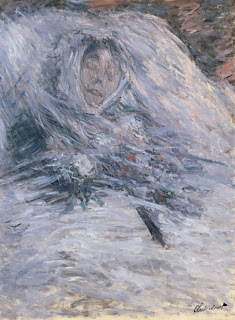Κυριακή 1 Σεπτεμβρίου 2013
Claude Monet: Camille on her Deathbed (1879)
Camille Doncieux (1847-1879) was Claude Monet’s wife and the inspiration as primary model for his paintings for 12 years. She as 19 and he was 25 when they fell in love and get married 3 years later. She died at 32 years, after giving birth to their second son, probably by cervical cancer or tuberculosis. Monet drew her in her deathbed and 40 years after her death. Monet spoke about to his friend Georges Clemenceau, the former French prime Minister:
"I found myself starring at the tragic countenance, automatically trying to indentify the sequence, the proportion of light and shade in the colors that death had imposed on the immobile face. Shades of blue, yellow, gray… Even before the thought occured to memorize the face that meant so much to me, my first involuntary reflex was to tremble at the shock of the colors. In spite of myself, my reflexes drew me into the unconcious operation that is the daily order of my life. Pity me my friend."
Was it an early phase of bereavement with his accompanying denial and disbelief that allowed him the objectivity to complete this final portrait? His signature stands out starkly on the painting, but he did not sign it and it was never exhibited during his lifetime; the painting was stamped with Monet’s signature after his death.
This painting evokes both her passing and her physical presence, the image is sweet, angelic, passive but also energized. The picture speaks not only about the changing colors of death that struck Monet’s personal fantasy, but also about his uncanny ability to evoke peace and pain, sorrow and celebration, essential conditions in order to deal with the reality of death. That year, of Camille’s death, marked a turning point to Monet’s private life and his entering to clear Impressionism in his style.
References: James C. Harris MD, Art and Images in Psychiatry, vol. 60, page 13, January 2003
Εγγραφή σε:
Σχόλια ανάρτησης (Atom)















.jpg)




Δεν υπάρχουν σχόλια:
Δημοσίευση σχολίου